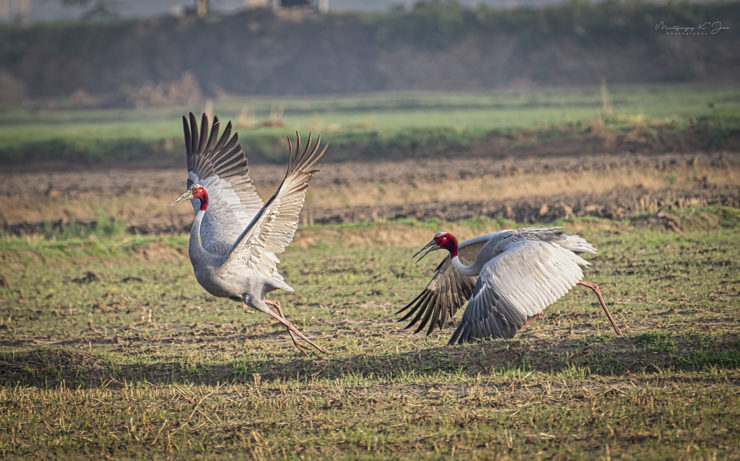![]() The world’s tallest flying bird has been getting a new lease of life in the Indian state where it enjoys the status of official state bird – Uttar Pradesh (UP). Uttar Pradesh is known as a stronghold of the sarus crane, India’s only resident breeding crane.
The world’s tallest flying bird has been getting a new lease of life in the Indian state where it enjoys the status of official state bird – Uttar Pradesh (UP). Uttar Pradesh is known as a stronghold of the sarus crane, India’s only resident breeding crane.
The International Union for Conservation of Nature (IUCN) has included this bird in its red list of threatened Species (also known as the IUCN Red List or Red Data Book). As per bird count data of 2018, there were only around 25,000 Sarus Cranes in the entire world, and significantly the birds in Uttar Pradesh make up more than half the global population at around 14000.
Uttar Pradesh, famous for Kashi, Ayodhaya, Lumbani and Taj Mahal, has provided enough space to its state bird.

At just over five feet in height, the sarus crane is the tallest flying bird in the world.
While scientists are “puzzled” how the species is thriving in the most populous state and is living in harmony with people. The farmers and villagers say that the bird Saras is entwined in the culture and mythology of the state. “They have been here for more than thousands of years. Sage Valmiki has references in his epic Ramayana. In Buddhism, it's said that in Lumbini, Prince Sidharth Gautam of the kingdom of Kapilvastu, is supposed to have rescued a wounded crane and saved it from his cousin Devdatta. Driven by this spiritual link, Lumbini has taken strides in protecting critical species and their farm habitats.
In modern day, Sarus Cranes hold a special relationship with the farmers of Lumbini as their presence in the paddy fields is believed to be indicative of healthy wetlands, a harbinger of good monsoon and good crops. Today the World Wildlife Fund (WWF), Wildlife Trust of India (WTI) with the help of the forest department successfully runs a Sarus Crane Breeding Centre in Lumbini near Gorakhpur.

Sarus cranes are easily recognised by the naked, blood-red patch on the neck and head, and also their beautiful grey plumage
In UP, Sarus cranes are mainly found in south-west and central regions, in Mainpuri, Etawah, Aligarh, Etah, Lakhimpur Kheri, Sitapur, Shahjahanpur Barabanki and Hardoi districts. The Sarus Crane Conservation Project, run across 10 districts of the state by the Wildlife Trust of India (WTI), in collaboration with Tata Trusts and with support from the UP Forest Department. The project works through local volunteers known as “Sarus Mitra” or Friends of the Sarus. Their efforts have led to the rise in Sarus numbers in state.
While around 70% of the population of Sarus is found in UP, the rest are distributed in Bihar, Madhya Pradesh, Rajasthan, Haryana, West Bengal and the north-eastern states.
Last Sunday, on a rainy and cloudy morning we were looking for monsoon birds in the wetlands and cultivated lands near Sultanpur, in Gurugram when we heard the “call”, followed by another, then another. We followed the calls and saw two pairs of Sarus cranes in the paddy lands running, hopping and jumping. Surroundings were filled with their calls.

The Sarus crane looks even taller when it stretches its neck, spreads its wings, and makes loud, shrill trumpeting calls
“It's their (Sarus) mating calls,” said the birder and photographer Kamal Sahansi. Sarus cranes often make vocal calls together, known as a “unison call”, the male starts the call while the female finishes.
When courting a mate, the male Sarus engages in elaborate “dances” interlaced with loud trumpeting calls. He hops, skips, and jumps to get their would-be mate’s attention.
The male is about 6 ft tall, his wings spread over 8-10 feet and dancing in front of the female who is slightly shorter than male. The bare red skin of the adult's head and neck is brighter during the breeding monsoon season. While the rest of the body is light grey, the adult has a white collar separating the red of the upper neck and the grey below. It was a sheer joy to watch them together. Like other cranes, the Sarus cranes form long-lasting pair bonds. They are considered symbols of marital fidelity, believed to mate for life and pine the loss of their mates, even to the point of starving to death. They are a symbol of marital virtue and in parts of Gujarat, taking a newlywed couple to see a pair of sarus cranes is customary.
Also Read: Did a monitor lizard help Shivaji conquer Sinhagad Fort: Legend says yes!




















